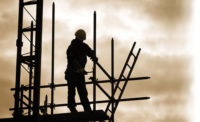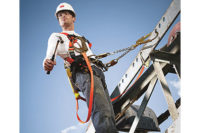While these types of structures present obvious fall hazards, the risk of falls can be found in many other everyday applications as well. Some are found much closer to the ground, leaving workers with either a false sense of security or puzzled as to how to protect themselves. Fall protection equipment manufacturers have been developing specialized equipment for such situations for years. Consider the following three applications that not only require the use of protective equipment, but present opportunities for workers to benefit from the use of specialized safety equipment.
Manhole openings
With the vast majority of public utilities buried underground, access to manholes is an essential part of a utility worker’s day. Since the opening tends to be at ground level, most people don’t think of a manhole opening as an at-height situation. In fact, manholes may lead to shafts that are deeper than 20 feet, which can lead to serious injury in the event of a fall.
Because manholes do not have a natural place for an anchorage connector above, specialized equipment is essential. One-piece tripods are a popular solution for manhole entries because they are user friendly and easy to set up. The worker simply places the three legs around the opening and attaches himself to the built-in pulley system directly above the manhole. For situations with overhead clearance restrictions or where the opening is too large for a tripod, a portable, multi-piece davit hoist system is good option. Although a bit more complex than a tripod, a davit hoist system is more versatile, offering various arm sizes and the capability to place the system next to the manhole instead of over it.
Fall protection around manhole openings is not only intended to protect the people entering the hole, but also to protect any worker standing outside of the opening. OSHA 1910.23 (a) (6) states that, “Every manhole floor opening shall be guarded by a standard manhole cover which need not be hinged in place. While the cover is not in place, the manhole opening shall be constantly attended by someone or shall be protected by removable standard railings.”
Ladders
There are many applications that involve vertical climbing on a daily basis, including work on communications towers, wind turbines, oil rigs, tankers, silos, bridges and even theme parks. The areas at the top of these structures usually have obvious fall hazards and therefore need to offer fall protection, but the actual climb up the ladder should not be overlooked.
A ladder safety system is the easiest way to protect workers from free falls without inhibiting climbing. These rugged systems include a detachable cable sleeve and a permanent steel cable that runs the length of the climbing area. The worker’s full body harness connects via the cable sleeve to the cable and trails below him during the ascent and descent of a climb. If the worker loses hold of the ladder and falls, the cable sleeve is designed to lock onto the cable and arrest the fall, allowing the worker to regain his footing.
Workers who regularly climb extremely tall structures, such as wind turbines, may also benefit from a climb assist system. Climb assist systems feature a portable motor which operates a moving rope or wire, providing weight relief to reduce fatigue and decrease the risk of injury. Climb assist systems are not always equipped with built-in fall protection, so be sure to work with a qualified safety equipment manufacturer to ensure worker safety.
Bucket trucks and aerial lifts
Bucket trucks and aerial lifts are traditionally equipped with some type of guard rail or raised side to prevent workers from falling over the edge. Fall hazards in these types of applications are typically remedied with a traditional harness and lanyard designed for fall restraint applications, or through the use of lightweight retractable lifeline devices. Some aerial lift manufacturers even
include approved anchor points within the lift for fall protection devices. But, even with the very best safety equipment in use, falls can still occur.
Many workers at these types of jobsites may find themselves working alone. If a fall occurs, they may be left dangling helplessly with no way to be rescued. This is not only uncomfortable for the fallen worker, but also dangerous as it could lead to suspension trauma. Specially designed self-rescue devices have been developed for these types of situations, providing a quick and efficient means of rescue after a fall. Some are manually operated using a pulley system, but many manufacturers are now offering automatic versions which are user-friendly and allow for a hands-free controlled decent to the ground, which is done entirely by the fallen worker.
Stay safe in any at-height situation
Even the most experienced workers can lose their balance, trip or misstep at any time. Accidents happen, and it doesn’t take a far fall to get seriously hurt. With a variety of fall protection equipment available today from reputable manufacturers to cover all applications, there is no reason to be unprotected in any at-height situation — no matter how unique the work site.



